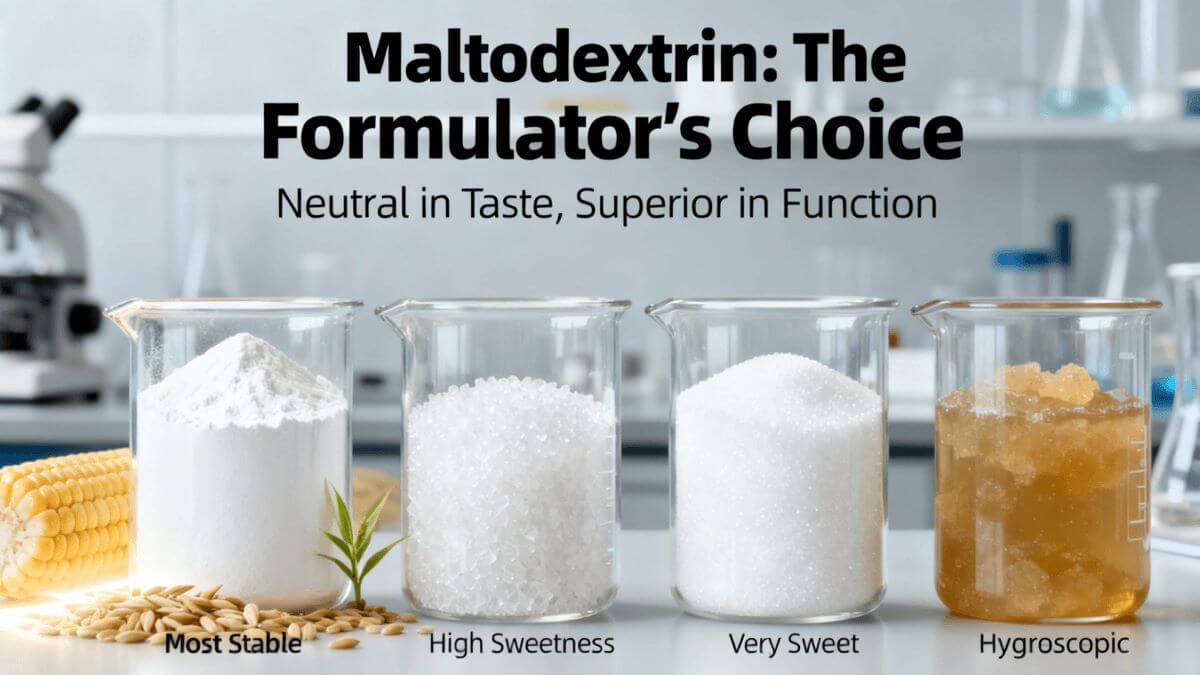For product developers and formulators in the food and nutraceutical industries, selecting the right carbohydrate is a critical decision that impacts cost, texture, shelf life, and consumer acceptance. Among the myriad of options, maltodextrin stands out for its unique functional properties. But how does it truly compare to other common carbohydrates like dextrose, sucrose, and corn syrup solids?
This guide provides a detailed, professional comparison to help you, the B2B decision-maker, choose the optimal ingredient for your specific application.
Understanding the Key Players
First, let's define our contenders:
- Maltodextrin: A complex carbohydrate (polysaccharide) produced from the partial hydrolysis of starch. It consists of a chain of D-glucose units and is typically characterized by its DE value (Dextrose Equivalent), which for our standard food grade maltodextrin is a versatile 10-20.
- Dextrose (Glucose): A simple sugar (monosaccharide) with a DE of 100. It is the building block of many carbohydrates.
- Sucrose: Common table sugar, a disaccharide composed of glucose and fructose.
- Corn Syrup Solids: Similar to maltodextrin but with a higher DE value (typically above 20), placing it closer to a simple sugar in functionality.
The Comparative Analysis: A Formulator's Perspective
Here's a breakdown of how these carbohydrates stack up against each other in key functional areas.
1. Sweetness
- Maltodextrin: Very low sweetness (typically 5-10% of sucrose's sweetness). This is its prime advantage, as it adds bulk and texture without making a product overly sweet.
- Dextrose & Sucrose: High sweetness. Dextrose is about 70-80% as sweet as sucrose. They are used when a sweet taste is desired.
- Corn Syrup Solids: Moderate to high sweetness, depending on the DE value.
When to Choose Maltodextrin: For savory applications, low-sugar or "no-sugar-added" products, and as a carrier for flavors and supplements where a neutral taste is critical.
2. Solubility & Viscosity
- Maltodextrin: Excellent solubility in water. It provides low to moderate viscosity, creating a smooth mouthfeel without excessive thickness. Our maltodextrin powder is known for its rapid dissolution.
- Dextrose: High solubility and low viscosity.
- Sucrose: High solubility but can form syrups with higher viscosity than dextrose.
- Corn Syrup Solids: High solubility and can contribute to higher viscosity than maltodextrin.
When to Choose Maltodextrin: For instant beverage powders, protein shakes, and soup mixes where quick dissolution and a light body are required.
3. Hygroscopicity (Moisture Absorption)
- Maltodextrin (Low DE): Low hygroscopicity. This means it is less likely to clump and absorb moisture, significantly improving the shelf life and flowability of powder blends.
- Dextrose & Sucrose: Highly hygroscopic. They can easily absorb water from the air, leading to caking and product instability.
- Corn Syrup Solids: Highly hygroscopic, similar to simple sugars.
When to Choose Maltodextrin: As a bulk filler and carrier in dry powder formulations, spice blends, and nutraceutical capsules where product stability is paramount.
4. Bulking and Carrying Capacity
- Maltodextrin: Exceptional. Its neutral flavor and low sweetness make it the ideal bulking agent to add volume without altering taste. It's also a superb carrier for oils, flavors, and high-intensity sweeteners, encapsulating them and ensuring even distribution.
- Dextrose & Sucrose: Poor carriers due to their high sweetness and crystalline nature.
When to Choose Maltodextrin: For creating standardized, free-flowing spice blends, encapsulating flavors, and as a primary filler in a wide range of food and supplement products.
Summary Table: Maltodextrin at a Glance
| Carbohydrate | Sweetness | Key Functional Property | Ideal Application |
|---|---|---|---|
| Maltodextrin | Very Low | Neutral bulking agent, excellent carrier, low hygroscopicity | Savory foods, low-sugar products, powder carriers, spray-drying |
| Dextrose | High | Rapid energy source, fermentation substrate | Sports energy gels, baked goods (for browning) |
| Sucrose | Very High | Sweetness, texture, preservative | Confectionery, desserts, sweet beverages |
| Corn Syrup Solids | Moderate-High | Sweetness, browning, humectant | Ice cream, certain confections |
Conclusion: Making the Strategic Choice
The "right" carbohydrate is not a one-size-fits-all answer; it depends entirely on your product goals. If your formulation requires a low-sweetness, high-bulk, and stable ingredient that acts as a flawless carrier, then maltodextrin is the superior choice.
Its versatility across the food, nutraceutical, and sports nutrition industries is unmatched. As a leading bulk maltodextrin supplier, Oclean Nutra provides consistent, high-purity maltodextrin that delivers on these functional promises.
Still Unsure? Let's Find the Perfect Solution Together
Navigating ingredient selection can be complex. Our technical experts are here to help you optimize your formulation. We offer a range of specifications and are ready to provide the support you need.
Request a Free Maltodextrin Sample to test its properties in your lab, or contact us for a competitive bulk quote and detailed technical data sheet.

